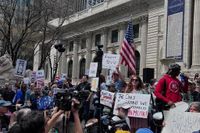NEW YORK (AP) — On Saturday, April 19, 2025, opponents of President Donald Trump’s administration took to the streets of communities large and small across the U.S., decrying what they see as threats to the nation’s democratic ideals. The disparate events ranged from a march through Midtown Manhattan and a rally in front of the White House to a demonstration at a Massachusetts commemoration marking the start of the American Revolutionary War on April 19, 1775.
Organizers said they were protesting against what they view as Trump’s civil rights and constitutional violations, including efforts to deport scores of immigrants and scale back the federal government by firing thousands of government workers and effectively shuttering entire agencies. Some of the events drew on the spirit of the Revolutionary War, calling for “no kings” and resistance to tyranny.
In Manhattan, protesters rallied against continued deportations of immigrants as they marched from the New York Public Library north toward Central Park past Trump Tower. “No fear, no hate, no ICE in our state,” they chanted to the steady beat of drums, referring to the U.S. Immigration and Customs Enforcement. Marshall Green, who was among the NYC protesters, expressed his concerns regarding Trump invoking the wartime Alien Enemies Act of 1798, claiming the country is at war with Venezuelan gangs linked to the South American nation’s government. “Congress should be stepping up and saying no, we are not at war. You cannot use that,” said the 61-year-old resident of Morristown, New Jersey. “You cannot deport people without due process, and everyone in this country has the right to due process no matter what.”
Meanwhile, Melinda Charles of Connecticut voiced her worries about Trump’s “executive overreach,” citing clashes with the federal courts to Harvard University and other elite colleges. “We’re supposed to have three equal branches of government,” she stated. “To have the executive branch become so strong, I mean, it’s just unbelievable.”
In Washington, Bob Fasick, a 76-year-old retired federal employee from Springfield, Virginia, came out to the rally near the White House out of concern over threats to constitutionally protected due process rights, as well as Social Security and other federal safety-net programs. The Trump administration has moved to shutter Social Security Administration field offices, cut funding for government health programs, and scale back protections for transgender people. “I cannot sit still knowing that if I don’t do anything and everybody doesn’t do something to change this, that the world that we collectively are leaving for the little children, for our neighbors is simply not one that I would want to live in,” Fasick said.
Thomas Bassford, an 80-year-old retired mason from Maine, drove to Massachusetts to witness a reenactment of the Battles of Lexington and Concord, commemorating “the shot heard ’round the world” that heralded the start of the nation’s war for independence from Britain. “This is a very perilous time in America for liberty,” Bassford said, attending the event with his partner, daughter, and two grandsons. “I wanted the boys to learn about the origins of this country and that sometimes we have to fight for freedom.”
Elsewhere, protests were planned outside Tesla car dealerships against billionaire Trump adviser Elon Musk and his role in downsizing the federal government. Others organized more community-service events such as food drives, teach-ins, and volunteering at local shelters. The rallies came just two weeks after more than 1,200 “Hands Off!” demonstrations drew thousands of protesters to streets across the country, from Midtown Manhattan to Anchorage, Alaska, to protest Trump and Musk.
In Denver, hundreds of protesters gathered at the Colorado State Capitol with banners expressing solidarity with immigrants and telling the Trump administration: “Hands Off!” People waved U.S. flags, some held upside down to signal distress. Thousands of people also marched through downtown Portland, Oregon, while in San Francisco, hundreds spelled out the words “Impeach & Remove” on a sandy beach along the Pacific Ocean, also with an inverted U.S. flag.
In Anchorage, Alaska, demonstrators walked through downtown with handmade signs listing reasons why they were protesting. One sign read: “No sign is BIG enough to list ALL of the reasons I’m here!” In Columbia, South Carolina, several hundred people protested at the statehouse holding signs with slogans such as “Fight Fiercely, Harvard, Fight.”
The protests come amid a growing sense of urgency among many Americans who feel that their rights are being eroded. As the demonstrations unfolded, voices from across the country echoed a collective call for action against perceived injustices. The spirit of resistance was palpable, as many protesters drew inspiration from the nation’s founding principles.
Boston resident George Bryant, who was among those at the Concord protest, expressed his deep concerns regarding the current administration. He held a sign saying, “Trump fascist regime must go now!” Bryant lamented, “He’s defying the courts. He’s kidnapping students. He’s eviscerating the checks and balances. This is fascism.”
As the day unfolded, it became clear that this was not just a series of protests but a significant moment in American history, a time when citizens felt compelled to stand up for their beliefs and push back against what they perceive as an overreach of power. The diverse range of voices and concerns highlighted the complexity of the current political landscape, with many Americans feeling a profound sense of urgency to protect their rights and freedoms.
With protests occurring in cities across the nation, the message was clear: many citizens are ready to fight for their rights and push back against what they see as an administration that threatens the very foundation of American democracy. As the dust settles from these protests, one thing remains certain: the fight for justice and equality is far from over.





